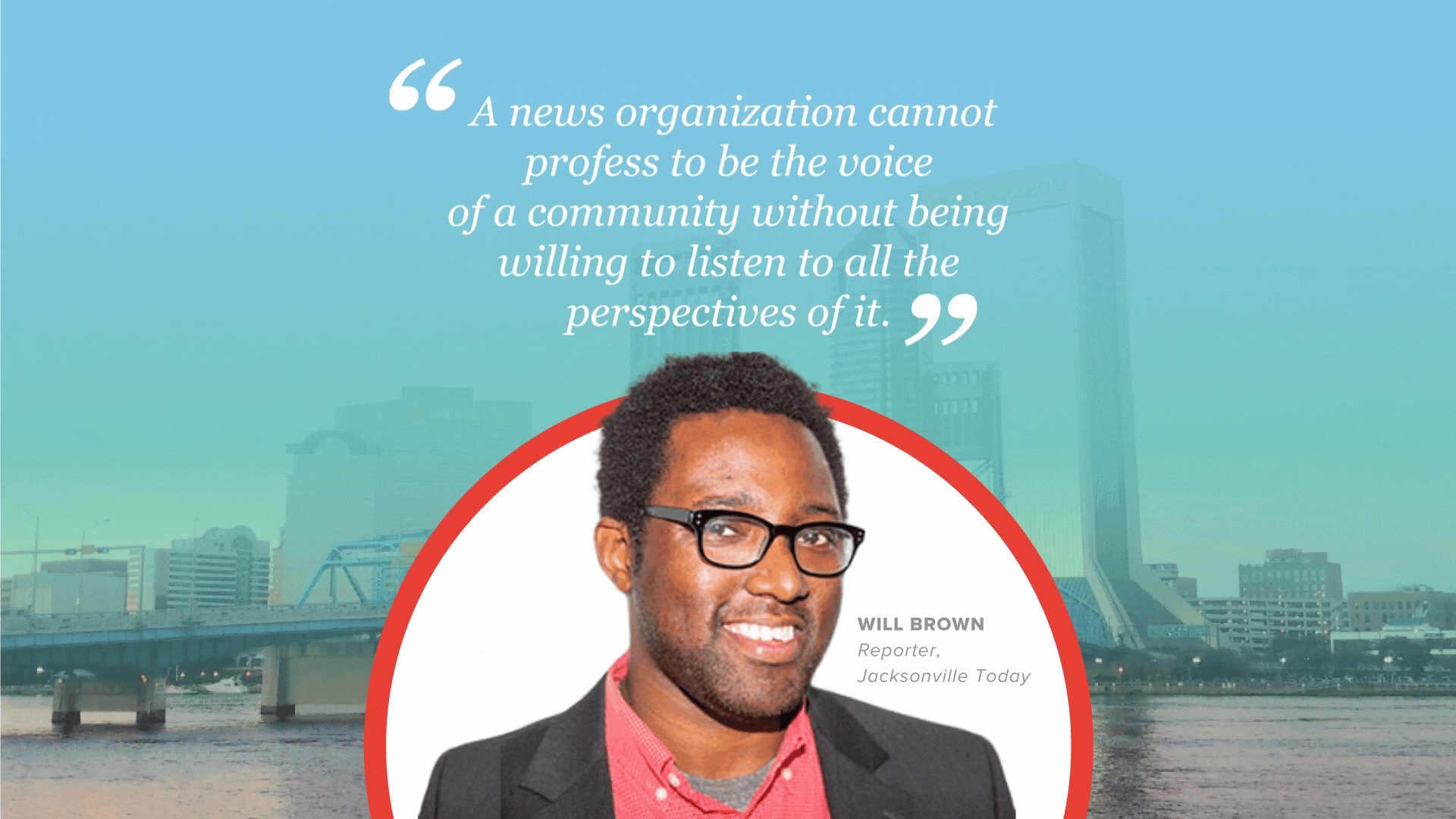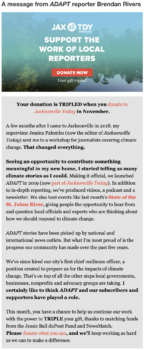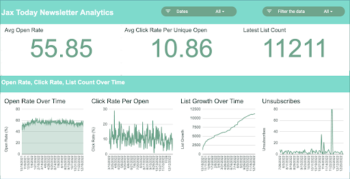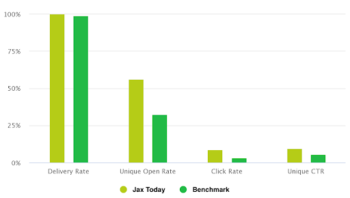Turn newsletter subscribers into donors, like WJCT Public Media did
Pete Havens, Ray Hollister, Jessica Palombo and Bonnie Zerr, WJCT Public Media,
A screengrab from Jacksonville Today's newsletter with a photo and quote from one of their local reporters
Here’s an idea to steal and adapt: You have a large list of engaged subscribers for your flagship newsletter. Reader revenue is the next challenge. Here’s an example of how a focused, personalized case for support can drive results.This is a series on Better News to a) showcase innovative/experimental ideas that emerge from the Knight-Lenfest Newsroom Initiative and b) share replicable tactics that benefit the news industry as a whole. This “win” comes from Pete Havens, director of revenue and business management; Ray Hollister, director of digital media; Bonnie Zerr, creative director; and Jessica Palombo, editorial director, all at WJCT Public Media, which participated in the Poynter Table Stakes program in 2022.
Question: What communities do you serve and what can you tell us about the history of your organization?
Answer: WJCT Public Media is Northeast Florida’s public media outlet, with a 60-year-plus history of serving a broad audience over TV and radio. Our viewing and listening area runs from Southeast Georgia down through North Central Florida, with the Jacksonville metro area at its center.
In 2021, WJCT Public Media announced its Local Journalism Initiative: a plan to strengthen local news reporting in Northeast Florida. In October 2021, we launched Jacksonville Today — starting with a weekday email newsletter that reports and curates local news, daily civic engagement opportunities, and columns on topics ranging from politics to urban planning in an easily scannable, shareable format.
Q: What problem were you trying to solve, and why was solving the problem strategically important for your organization?
A: The Jacksonville Today team had spent most of the first year of publication focusing on making the best local newsletter possible and getting it in as many inboxes as we could. When the time came for a two-month reader revenue push at the close of 2022, the newsletter was reaching close to 11,000 readers. The goal was to begin generating reader revenue, serving WJCT Public Media’s broader goals of diversifying revenue streams and achieving financial viability for Jacksonville Today for the long term.
We had never completed an all-digital fundraising campaign before and had no benchmarks for comparison, so for budgeting, we set modest goals we thought we could achieve, especially considering our fiscal year forced us to budget before knowing the full amount of secured matching dollars.
With two matches secured, we aimed to raise enough to earn the maximum amount of matching funds – $40,000 from November to December. Beyond that, we hoped to continue to fundraise throughout 2023 and ultimately convince roughly 5% of our newsletter subscribers (about 550 people at that point) to support our work over our full fiscal year (October 2022 through September 2023).
With a modest web audience on jaxtoday.org, the primary audience for our fundraising appeals were the newsletter subscribers who received Jacksonville Today in their inbox five days a week. We deployed a mix of in-newsletter “toppers” (sections of the newsletter with a fundraising message) and standalone emails throughout November and December. We believe the content of these messages was critical to the success of the campaign.
While we did use some standard fundraising copy, the bulk of each message was personal – written by Jacksonville Today journalists about how they came to do what they do, their passion for local reporting and some of their most impactful reporting. Readers were able to match a face with their donation in support of local reporting.
We asked our news team how they got to where they are, what reporting on local news means to them, and why it’s worthy of support, and then bookended that message with a pitch for a donation (see examples below).


The messaging also asked for reader support at a critical time when match funding was in place, which made their impact most effective. In November, any donation in support of Jacksonville Today‘s work netted at least a triple impact thanks to NewsMatch funding and a local match from the Jessie Ball duPont Fund.
For 24-hours only during Giving Tuesday (or #GivingNewsDay), supporters’ gifts were quadrupled thanks to an extra match by the Jessie Ball duPont Fund.
The results were compelling: From Nov. 1 to Dec. 31, 2022, Jacksonville Today added more than 520 donors with an average gift of $93, just under half of whom had never given before to WJCT Public Media. Some even donated twice when the added match came on Giving Tuesday. We far exceeded our fundraising target.
More important than any dollar total was the fact that more than 500 loyal subscribers – almost 5% of our newsletter list, our goal for the year – were compelled to donate. They expected nothing in return but the knowledge that their community local news service was a bit more financially viable. They told us why via the donation form:
“I appreciate being informed of local news and events in a concise and positive way. I feel more connected to the community I live in thanks to your weekday offerings.” –Dianne from Fairfax
“You have hit a unique niche in local reporting and news. Very well done, informative and often makes me smile.” –Kristi from East Arlington
“Our need for accurate and well-written news is more important than ever. Thank you, Jacksonville Today!” April from St. Augustine
A recent paper by the Shorenstein Center at Harvard posits that public media can and should play a larger role in solving the local news crisis in America — if, that is, stations can accelerate their digital transformation.
Jacksonville Today is an example of a digital news operation that has begun within — as opposed to the larger amount who have been acquired by — a public media organization. Its creation means we grapple a bit with an internal culture clash between public media’s traditional fundraising and community engagement in the linear broadcasting space and speaking to a digital audience with an all-digital campaign. But as we learned, aside from the medium, it’s not different by much. And that’s good news for everyone.
At WJCT, Jacksonville Today fundraised during a radio pledge drive and a TV pledge drive in the same time frame and with overlapping audiences. We expected and braced for “cannibalization” of traditional fundraising dollars. Lo and behold, it happened at a roughly 50% rate. But surprisingly, the organization raised more dollars from the 50% of people who supported Jacksonville Today and WJCT in 2022 that was raised from those same donors in years prior. That’s a big win we didn’t expect.
And once again, the real win is qualitative. Knowing WJCT Public Media supporters chose to give more because they saw the value of that separate initiative makes us want to work even harder to enhance the quality and quantity of our product.
Q: How is this approach related to Table Stakes (e.g. one of the 7 Table Stakes and/or an outgrowth of the Knight-Lenfest initiative, etc.)?
A: This relates primarily to Table Stake No. 5 (“Diversify and grow the ways you earn revenue from the audiences you build”).
Q: How did the organization’s focus and workflows change when Jacksonville Today launched?
A: Launching in a non-broadcast medium allowed us to use our public media fundraising know-how in a new way — an all-digital campaign.
With Jacksonville Today’s fundraising, we wanted to put a face to the reporting and allow potential donors to get to know the people whose livelihoods depend on their support.
But this approach didn’t just start in the fundraising space, and we think it wouldn’t have been as effective if so. It started with a personal approach to the newsletter, before any fundraising.
There are no shortages of local and national ‘3 Things You Need to Know Today’ emails with curation done by an algorithm. By contrast, Jacksonville Today is written and compiled each day by a newsletter editor and a newsletter writer, who inject their personality and sign off with a personal message every morning. That same newsletter writer will personally send another email later in the day with a correction or update, if needed.
The team also jumps at any chance to include reader-submitted questions with the “#AskJAXTDY” section, reactions in the “Your Take” section and good news in the “Little Bit of Joy” section, with the goal of striking a positive tone and encouraging a two-way conversation. This is all time-consuming but quite important to garner trust and build habit from readers.
Q: What was so important about creating a digital product?
A: Public media is changing in similar ways to how the newspaper industry is changing. Audiences are shifting to digital.
We chose to start as a newsletter, a relatively low-entry-cost way to foster reader loyalty while fulfilling our Jacksonville Today mission — producing and distributing audience-engaged journalism that expands civic discourse and fosters a vibrant, inclusive, and knowledgeable community.
Jacksonville Today has maintained an above-50% open rate (with the caveat that Apple’s Mail Privacy Protection may be the cause of some inflation of that statistic), a roughly 10% click rate per unique open, and a very healthy list growth rate as we approach 15,000 readers in March of 2023.
Another lesson: We learned that when we fundraise, some of our audience unsubscribes (see the spike on the bottom right) — but not at a rate that makes us think twice about the fundraising, just one that prompts us to be strategic about timing.

These stats (from December 31, 2022) compare favorably to industry norms for newsletter and digital magazine deployments, using benchmarks for the fourth quarter of 2022 compared with our own data for that quarter (comparison/industry data provided by Omeda):

Q: How did you go about raising capital for Jacksonville Today?
A: Jacksonville Today gained capital from the WJCT Public Media Local Journalism Initiative, a campaign that includes funds from local and national philanthropic foundations as well as local major donors.
When significant initial funding was secured we turned our efforts to educating the local philanthropic community about the need to support local news in their giving priorities by bringing national leaders to Jacksonville: Sue Cross of Institute for Nonprofit News, Dick Tofel of ProPublica, Judy Woodruff of PBS NewsHour, and most recently Charlie Sennott of Report for America. (Charlie Sennott’s hour-long conversation with WJCT Public Media President/CEO David McGowan is available here if you would like to watch.)
These events are meant to educate people on what is happening in the news ecosystem and why they should support local news.
Through foundational support and individual philanthropists, to date our campaign has raised 86% of its $2.5 million goal. These funds are used as a runway for us to grow our staff and our audience and begin diversifying our revenue streams beyond philanthropy — reader revenue, newsletter sponsorships and more.
Q: Describe the technology used for your donation drive and fundraising efforts.
A: We ended an exhaustive search for a dynamic giving platform with the choice of GiveWP, a tool that connects seamlessly to our WordPress CMS (Content Management System) and allows us to customize and optimize mobile-friendly donation forms without intense coding, completes the donation on one page and includes the ability to turn those forms into popups and embedded elements on our news pages (along with a host of other helpful features).
We used UTM parameters (codes within the URL link to our donation page that allowed us to track how people arrived at the form in Google Analytics) in every donation link. Donors who give to Jacksonville Today are also provided with a link to a donor dashboard where they can see their donation, make changes to ongoing gifts, and download receipts and end-of-year giving summaries.
During the fundraising drive, we sent personal thank-you emails to every donor. This is not a mass-message — we hit send roughly 500 times to follow up on each donor’s automated receipt (a time-consuming task if there ever was one). We thanked them, included a link to a personal thank-you video from our editor, and asked them for a testimonial and the permission to publish it.
Outside of the email campaign, we did paid advertising on Facebook with the help of a digital advertising firm that created and managed our ads. We also implemented a donation popup on our website, but we only reached that level of reader interruption during our most critical fundraising hours on Giving Tuesday.
Q: What messaging is most important to get across to donors and funders?
A: The most important messaging, for us, had to do with the stories of our local reporters — how they got into reporting, the twists and turns of their careers, the most important stories they have been a part of, why they come to work every day, and how they strive for relevant, actionable, thorough and fair coverage of issues that help our local audience to be informed.
It also cannot be overstated how important the match funding was for donors, including putting what that means into real terms (a.k.a. “Give $60, we get $180” or “you have “x” days, hours, minutes until the match expires”). That urgency and the multiplication of the donor’s impact, we think, was a tremendous factor to the success of the drive (an example below).

Q: What advice would you give to others who try to do this?
A: This is what worked for us, a local digital news outlet within the public media framework of our organization in a midsize city. It’s by no means the rulebook for all!
We would suggest starting your planning early, testing your technology, and tracking everything so you can measure your success. Also, if this campaign will be “owned” by you, clear your schedule as much as you can, especially toward the end of the campaign — it will take up more of your time than you can imagine.
Set a reasonable goal for how many messages to send. You can add a few (at most) mid-campaign, but don’t overdo it. “Back-load” your messages for the most critical time (a.k.a. end of the drive, your time-is-running-out messaging). Include timers in each message showing how close you are to reaching the end, especially if a match is involved. A timer may be more effective than a progress bar; the latter could make a potential donor feel like their contribution is just a drop in the bucket.
Make test donations in every way possible on your form, often, with every form of payment, even in the middle of your campaign. Make them with small dollar amounts of real money, even if you have to refund it later (but do this before it throws off your statistics).
You don’t always have to send messages to your full audience. If you have a way to segment your audience, try it, and send different messages to each group. Compare the results. We did this with our WJCT audience (those for whom Jacksonville Today wasn’t their first interaction with us) and our “Jacksonville Today only” audience. If you can’t do any segmenting, at least try to leave out the people who gave to you in the last email and don’t send anything to them but personal thank you messages, and your final “end of drive” thank you message en masse.
Click on every “donate” link in every email, popup, or social ad after every edit you make, to make sure it still works. Send multiple tests to colleagues for editing and testing of links. There’s nothing worse than regretting hitting send.
Don’t have multiple donation forms. Find a way to put every “way to donate” and every message you want people to see onto one single form, and send all traffic to one place. You have no idea who is going to click on what, and you want them all to donate, so don’t assume anything about them once they reach that form. Segment your audience when you’re sending messages, not on your donation forms on your website. Examine that donation form for pinch points, and make adjustments if needed. Pay attention to any feedback donors take their valuable time to give to you.
Don’t be afraid to pivot, try new things, or employ new messaging mid-campaign — as long as you can test and track the results.
Q: Is there anything else you’d like to add?
A: Our team is always available to answer any questions. Just email us at hello@jaxtoday.org.